By Tim Morrissey, Senior Aquarist
Omaha, Nebraska might not be your typical destination for viewing coral reefs, with the nearest coral reefs occurring 110 miles south of the Texas-Louisiana border, but tucked away in the middle of the country, at Omaha’s Henry Doorly Zoo and Aquarium, there are a variety of coral exhibits. One of the largest reef tanks at the zoo is the Indo-Pacific reef tank.
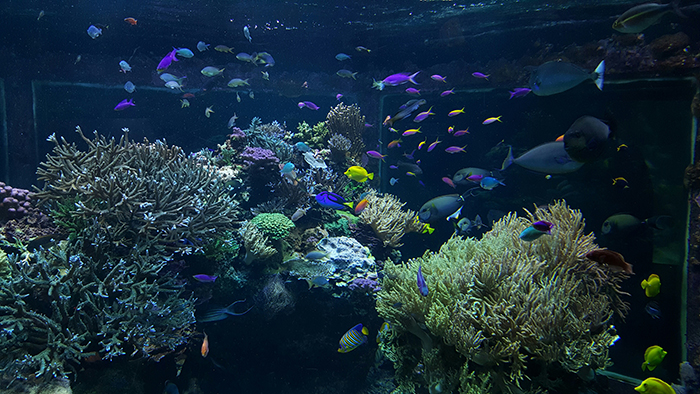
The 8,000 gallon display tank at Omaha’s Henry Doorly Zoo and Aquarium. Photo by Tim Morrissey.
History
The display tank is roughly 8,000 gallons with a total system volume just shy of 20,000 gallons. It is the definition of a mixed-reef tank, housing a dense population of fish and a myriad of corals. It is hexagonal in shape and has five viewing windows (which are cleaned with a mighty magnet every other day). The back panel is where all of the plumbing and flow is located. The tank was converted to an Indo-Pacific reef tank in 2011 when the aquarium was renovated.
I took over the tank in the middle of 2013, but it wasn’t until October that the tank could successfully house corals. There were a few LPS and soft corals that were surviving or slowly dying in the tank, but nothing was really thriving. Something was impacting the corals, possibly a heavy metal, which was leeching out into the water. This is still an issue to this day. Some species handle it better than others.
In the past, corals were added to the tank and they would grow very quickly, encrusting the rocks and putting out new branches. Then, a couple weeks would go by and polyp extension would decrease, followed by slow tissue recession and eventually, if left in the tank, the corals would die. If the corals were transferred to a propagation system downstairs, they would rebound quickly. It was very odd to have them growing so fast, but dying on exhibit.
Joe Yaiullo was in town speaking at the Nebraska Aquatic Supply anniversary event, so I got in touch with him and presented my situation. He suggested that I run GFO (granular ferric oxide or phosban) on the tank to strip out what was in the water and noted that he has had various species, for whatever reason, not thrive in his big tank. I have also found this to be true in our exhibits. Some corals do great in one system but not in the other. Taking his advice, I quickly modified the chemical filtration on the tank. There was one 6-inch reactor about 5 to 6 feet tall that had housed some cuprisorb trying to pull out heavy metals, and a second 6-inch reactor about 3 feet tall that housed mainly carbon and some GFO. I replumbed these into a closed loop upstairs above the exhibit and turned them both into GFO reactors. I haven’t measured, but I would guess, between the two reactors, they hold about 25 pounds of GFO. I had never used GFO in this capacity before. I knew it was supposed to be tumbled but wasn’t sure what flow would be ideal.

Dual chamber calcium reactor on the left, two GFO reactors center, kalkwasser barrel right. Photo by Tim Morrissey.
I was anxious to try corals with the new GFO reactors replumbed and filled to capacity. I added various Acropora sp. and Montipora sp. and to my delight they did great! This was awesome, but I still had some learning to do. How long would the GFO sustain the corals? It turns out, after about 3 months of GFO, the corals started to decline. I also learned, the Acropora sp. “Fuzzy Wuzzy” (a green with orange tip staghorn-like species), which grew the best in our propagation system, just wasn’t suited for the big tank. That was the coral being used most commonly as the guinea pig because we had so much in propagation. However, it wouldn’t make it long term on exhibit while the other species ended up thriving. Once I noticed the corals declining, I changed the GFO and all of the species that were declining rebounded. Since then, the GFO has been changed every three months. The other hurdle I ran into was determining how much water to put through the reactors. The first time I went to change the GFO, it had turned gray and solidified. This ended up being a real pain to chisel out of a big reactor. I now run the flow a little higher and haven’t had any issues.
Other Life Support
The mechanical filtration is accomplished by two Stark 48-inch rapid sand filters. They are run off a 15-horsepower pump that is valved down to achieve a flow rate of about 190 gallons per minute. Heating and cooling is achieved via a titanium plate heat exchanger fed off a closed loop from the sand filter loop by a 5-horsepower pump. This is a very efficient way to heat and cool the tank. It uses the hot and cold water loops in the building that are supplied from a central plant on zoo grounds. A temperature probe is hooked up to a computer that can send email alerts to staff if the temperature is out of range. The temperature is set at 78 degrees Fahrenheit.
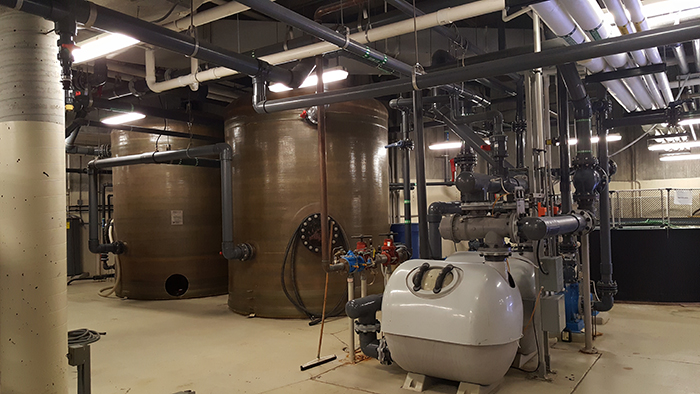
5,000 gallon reservoirs left, sand filters right. Photo by Tim Morrissey.
The system also incorporates two 5,000-gallon reservoirs. These vessels only purpose is to provide extra water volume. Historically, most systems here were designed to have equal or greater water volume off exhibit as on exhibit just as a dilution factor. Dilution is the solution to pollution! Now we have better technology so we can achieve pristine water quality without such a dilution, but I still think it has played a big role in the success of the tank. In my opinion, the single most important thing that it achieves is stable alkalinity, which, to me, is the most important water chemistry for keeping stony corals. In a smaller system, with a greater density of coral per gallon of water, alkalinity shifts can be more common.
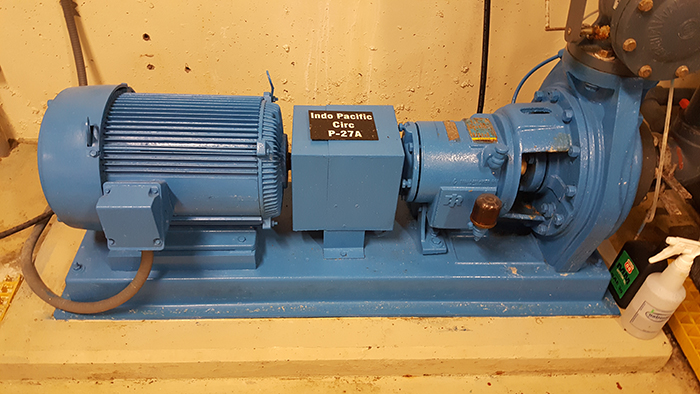
15-horsepower main circulation pump. Photo by Tim Morrissey.
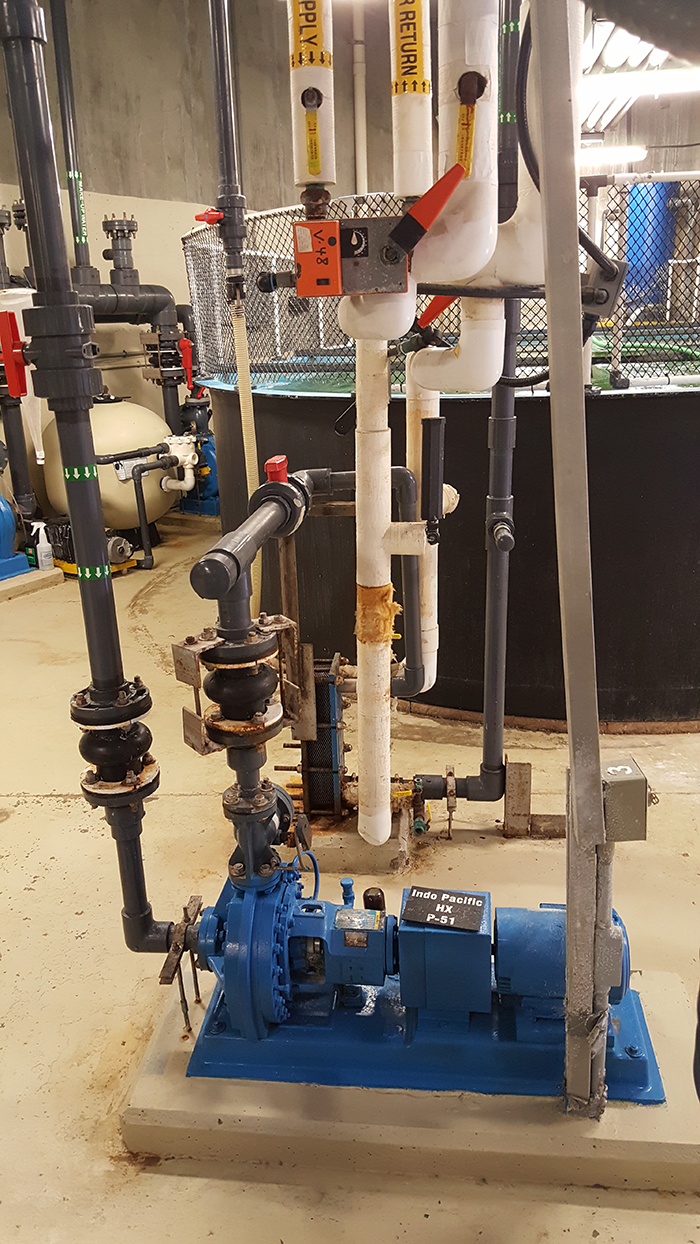
Pictured in front, the 5-horsepower heat exchanger pump, and titanium plate heat exchanger in the rear. Photo by Tim Morrissey.
The calcium reactor for this tank is a homemade 8-inch clear PVC reactor that uses a Dart pump as a circulation pump. It stands about 6.5 feet tall and is filled with Reborn media from Two Little Fishes. A pinpoint pH controller controls CO2 from an Aquarium Plants CO2 Regulator. The second chamber is a 10-inch PVC reactor about 3 feet tall that is also filled with GFO. It is fed off of the closed loop 3-horsepower pump. The 3-horsepower pump supplies the calcium reactor, two GFO reactors, two 1.5-inch eductors in the tank for circulation, and the protein skimmer.
The protein skimmer is an MRC Industrial Series Needle-Wheel Fractionator Model IS-36108. For those of you wondering just how big it might be, I bet it holds more water than most people’s home aquariums. The diameter of the skimmer body is 36-inches and stands a mere 108 inches tall. The needle wheel pump is a 2-horsepower baldor motor. The protein skimmer also functions as the ozone contact chamber. Ozone is injected at a rate of 0.08 SCFH (Standard Cubic Feet per Hour). The ozone greatly increases water clarity.

MRC Industrial Series Needle-Wheel Fractionator Model IS-36108. Photo by Tim Morrissey.
Flow is achieved via the eductors and a Hydrowizard ECM 75. It is hard to quantify the flow from the eductors because there are no flow meters on them, but the tank has six eductors, three on each side. I choose to use only two, which are on the same side. This creates a somewhat circular flow in the tank. The circular flow is broken up by the pulsing hydrowizard. It is set to the wave mode, but doesn’t make a sloshing wave in the tank. You can see the soft corals, and LPS corals swaying in the flow though, which to me, provides a very calming look. It is set at 79%. The surgeonfish like to get in the hole where the water pulses out of and eat algae. It is quite comical when one gets tossed out, flipping and summersaulting though the tank!
Lighting
Lighting is provided primarily by metal halide lamps. There are 9x 1,000w metal halide lamps with the bulb oriented vertically to provide more punch. The bulbs are Sunmaster 5,500k Blue Ice. I know you guys are probably re-reading that because 5,500k and blue are not normally used together, but the lights provide a very nice white light, more akin to a 10,000k bulb in my opinion. When they are due to be changed, they shift to a more pinkish hue, which does give the tank a yellow look. To offset this, there are two 400w, 20k radium bulbs over the archway and a 120w Ecoxotic blue LED lamp. These give the tank a more balanced look. I would like to add more blue light down the road. There just aren’t many options for bluer 1000w bulbs. I tried a batch of Hamilton 14k bulbs and half of them burned out in less than a year. I think, ideally, I would add more blue light via LED supplements like the 120w Ecoxotic pendants. As for going all LED, so far I haven’t been satisfied with the LED replacements for 1,000w lights. I have tried 500w Maxspect and Orephek pendents and they just don’t light the tank up the same. It looks dim.
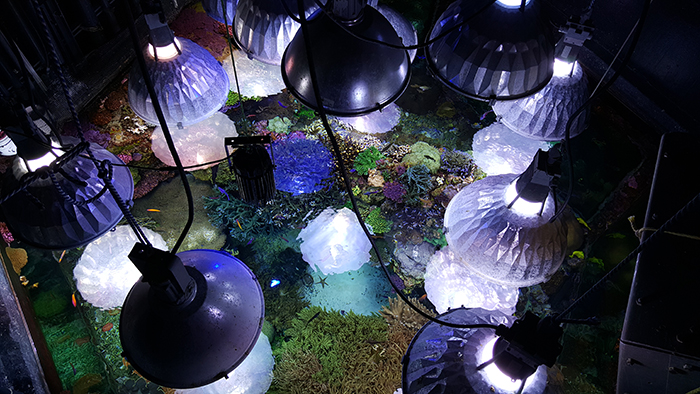
Top down view showing the lights. Photo by Tim Morrissey.
Livestock
My favorite part! I am a fish nerd at heart. This tank houses and has housed some pretty cool fish. Two species stand out as my favorite past residents. There was a group of Cirrhilabrus aurantidorsalis, Orange-Back Fairy Wrasse. Some of you wrasse nerds are probably yawning at the mention of such a common fish, but these fish were different from the small, young fish you see in the hobby. These were 6-inch (bigger than most literature puts them at!) behemoths. They caught your eye from across the room with solid blue, purple and orange.
The other species was Scarus rivulatus, the Surf Parrotfish. This isn’t exactly a common fish. This individual came in mislabeled as Scarus quoyi, a Quoyi Parrotfish. It quickly became a favorite of visitors. You could often hear kids showing their parents the “rainbowfish.” And contrary to popular belief, it was completely reef-safe. I think we would find that many of the smaller species of parrotfish would be reef-safe if they are ever imported on a regular basis. The smaller Caribbean species such as S. iserti and S. taeniopterus have behaved very well in reef tanks. I have also kept a juvenile Cetoscarus bicolor in an SPS propagation tank for the last year with no issues. It is just an idea now, but I suspect the main coral munchers are the huge parrotfish, and maybe they only eat corals as they mature or in the absence of sufficient algae. More work observations are needed in this department, though. Back to the S. rivulatus, the scribbling on the face and “rainbow” of colors were unmatched. Also, the torpedo body shape and prominent beak made it stand out. I am currently on the hunt for another one of these amazing fish. It was the perfect size for this tank, too, around 10 inches. However, due to its maximum size, I wouldn’t recommend it for the average hobbyist’s aquarium. Unfortunately, it picked one too many fights with the 4 resident Acanthurus maculiceps, Maculiceps Tangs. The parrotfish died from a slash from a tang.
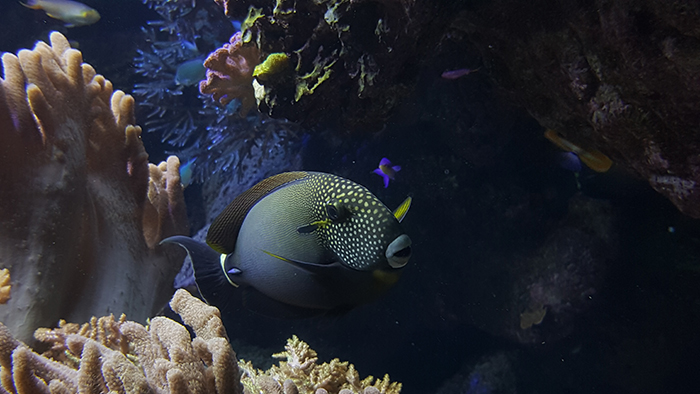
Acanthurus maculiceps, Maculiceps Tang. Photo by Tim Morrissey.
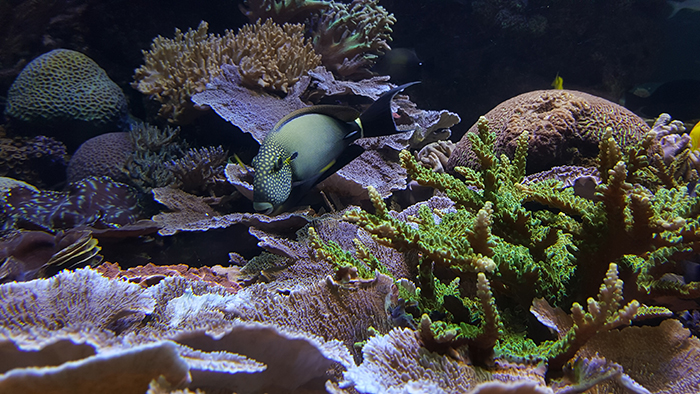
Acanthurus maculiceps, Maculiceps Tang. Photo by Tim Morrissey.
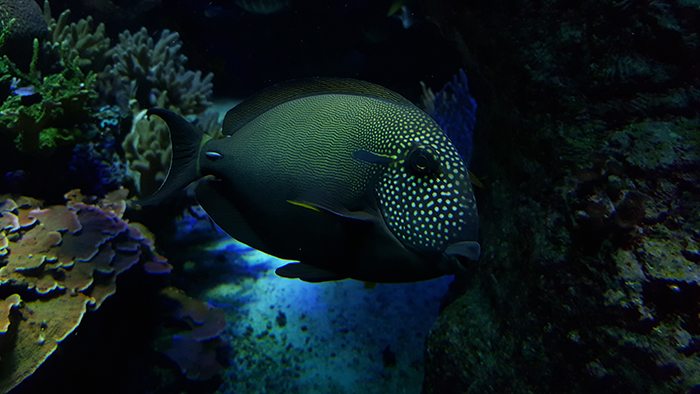
Acanthurus maculiceps, Maculiceps Tang. Photo by Tim Morrissey.
Of the current residents, the newest fish, and my new favorite is a Yellow-Belly Regal Angelfish, Pygoplites diacanthus. The pattern of angelfish are just so much more striking than that of other fish. The vertical bars catch your eye, and the anal fin color is like no other. Those who know me know my favorite fish is the newest fish, but this guy might hold that position for a while. Close seconds would have to be the Genicanthus lamarck male with huge streamers, Cirrhilabrus roseafascia, Anampses chrysocephalus, Anampses neoguinaicus, Acanthurus nigricans x A. leucosternon, and the huge harem of Pseudanthias tuka, P. pascalus, and P. evansi, or as the public calls them “purple fish”. Lemon has documented the P. pascalus from this exhibit before and the males are a sight to behold.
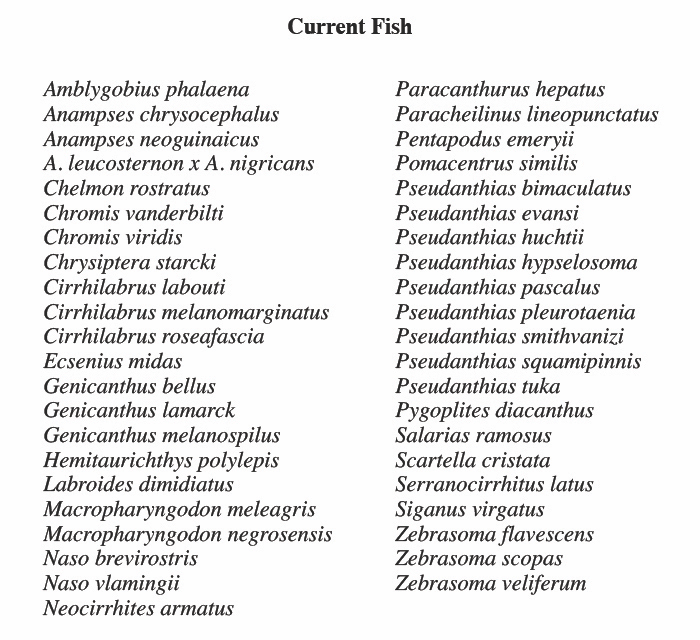
I didn’t include quantities because honestly, I don’t know them all. The big fish are easy to count, but chromis and anthias are so abundant that any count would just be a guess.
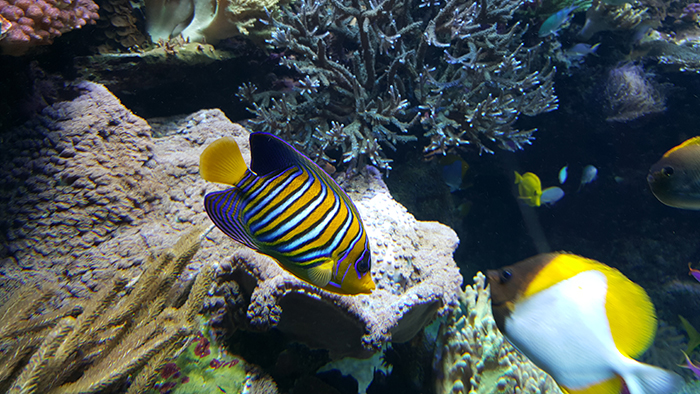
Pygoplites diacanthus, Regal Angelfish. Photo by Tim Morrissey.
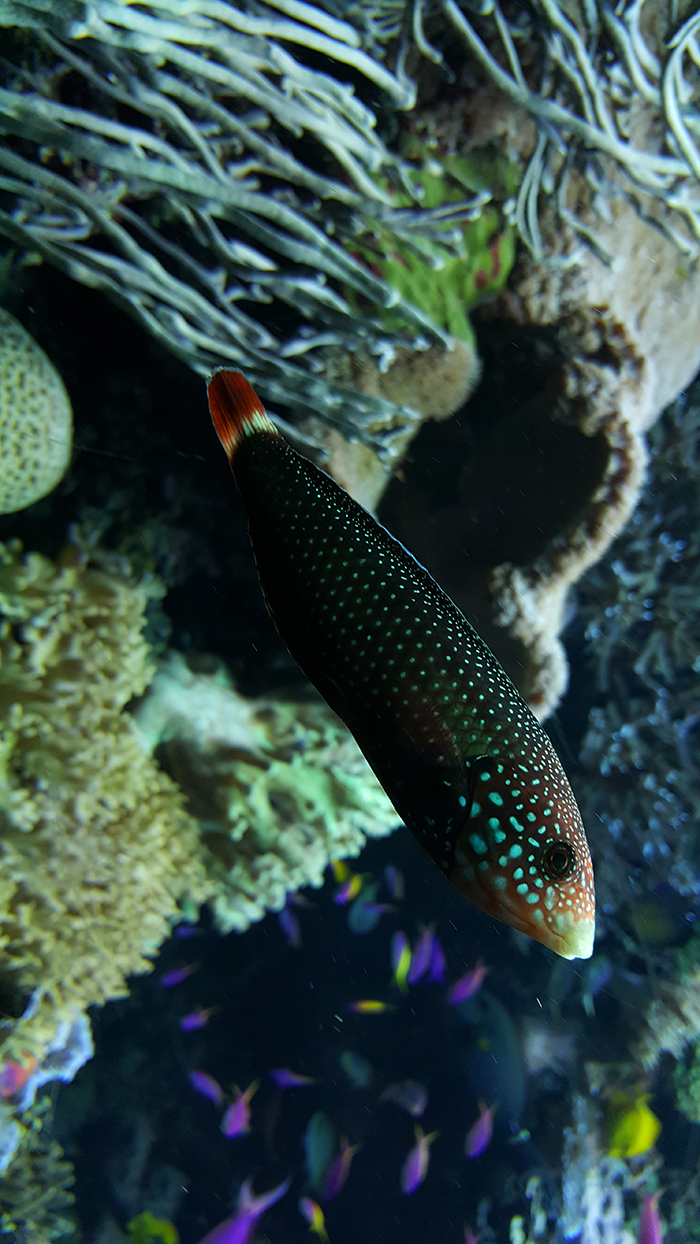
Anampses chrysocephalus, Psych-head Wrasse. Photo by Tim Morrissey.
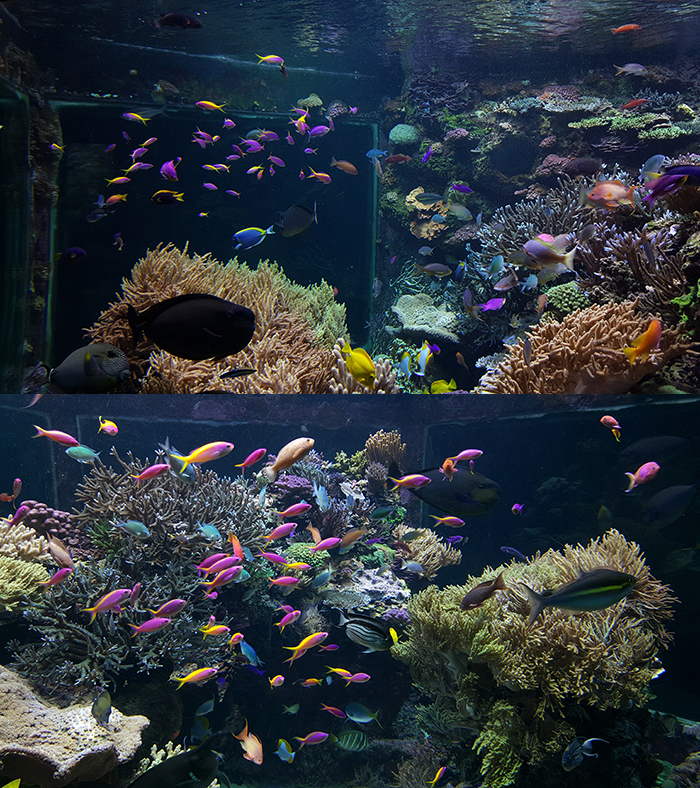
Grouping of various anthias. Photo by Tim Morrissey.
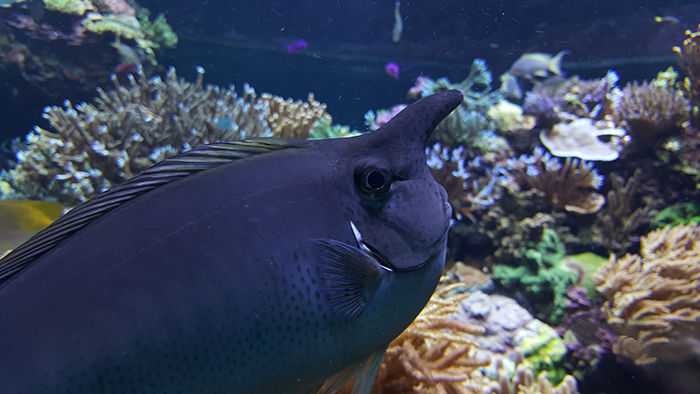
Naso brevirostris, Unicorn Tang. Photo by Tim Morrissey.
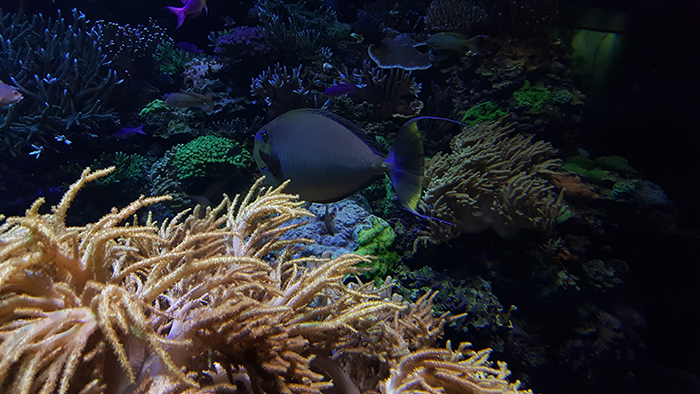
Naso vlamingii, Vlamingi Tang. Photo by Tim Morrissey.
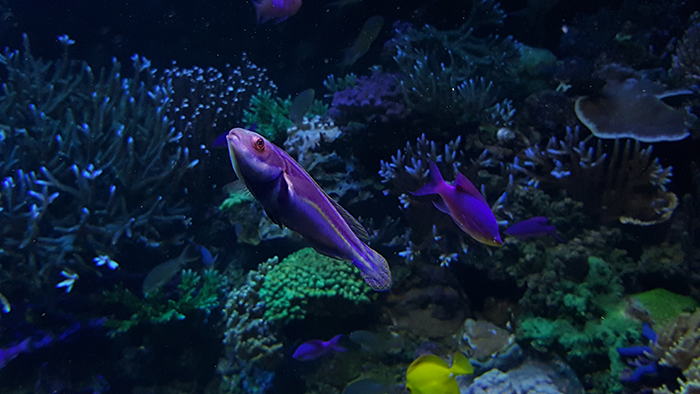
Cirrhilabrus labouti, Labout’s Fairy Wrasse. Photo by Tim Morrissey.
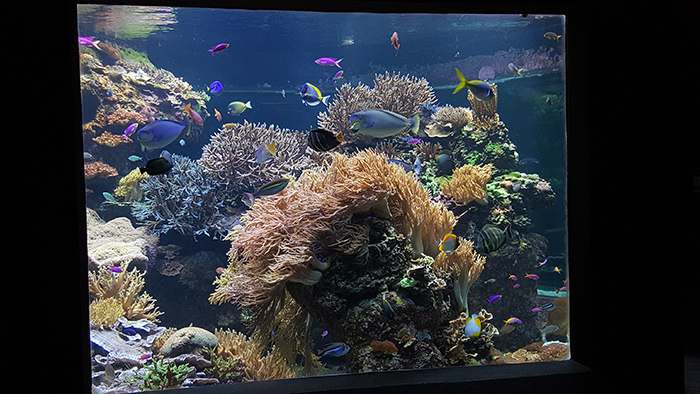
View from the second window. Photo by Tim Morrissey.
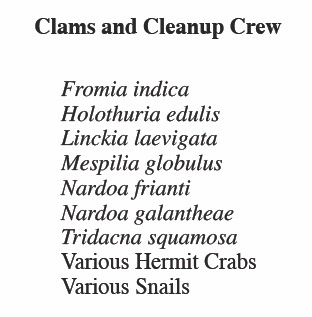
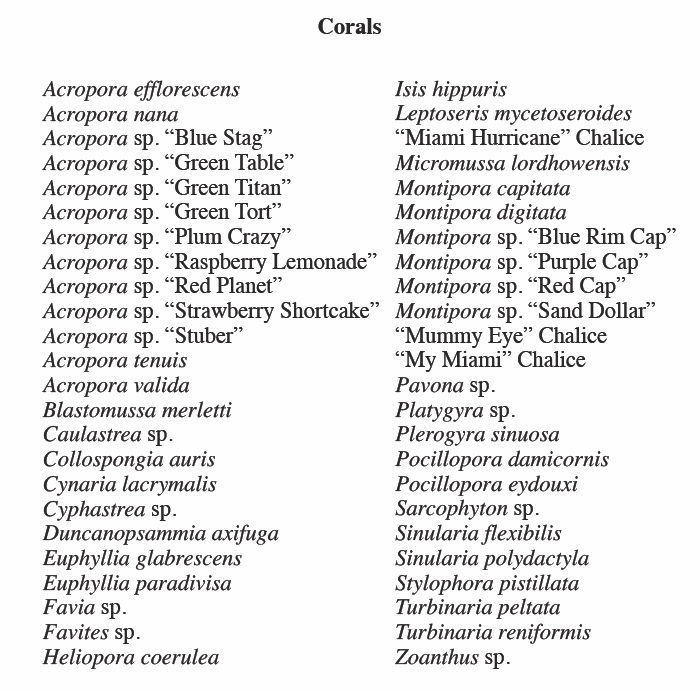
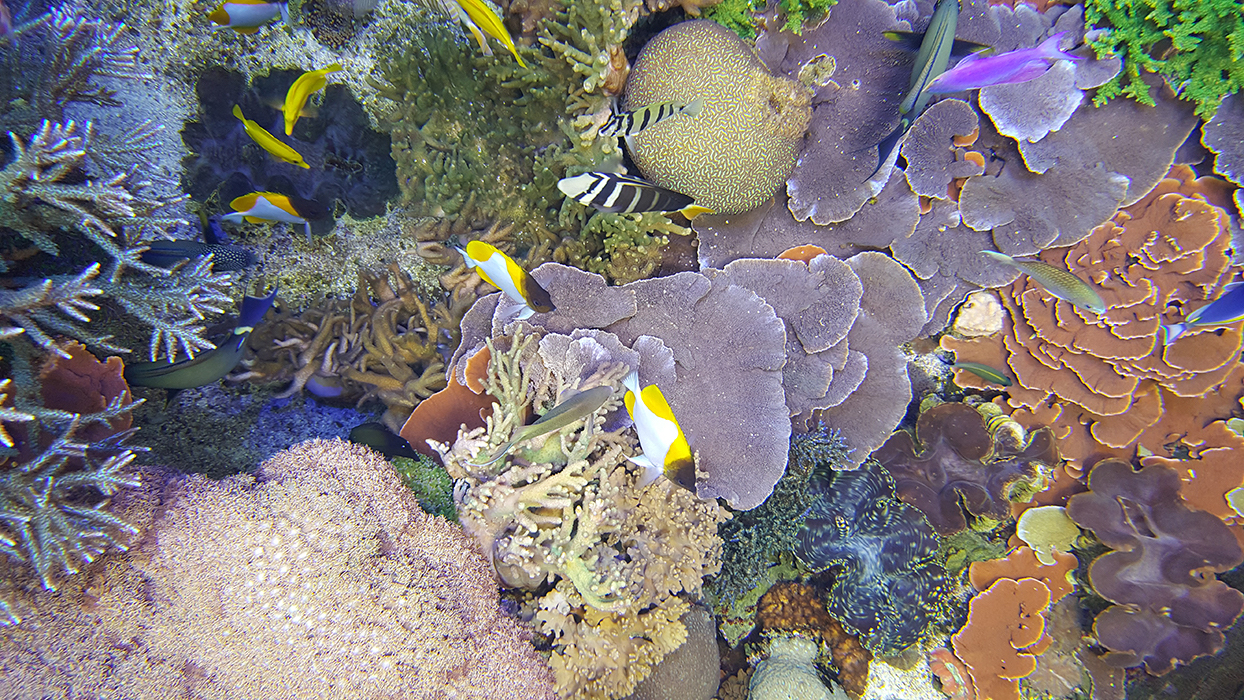
Top down view near the first window. Photo by Tim Morrissey.
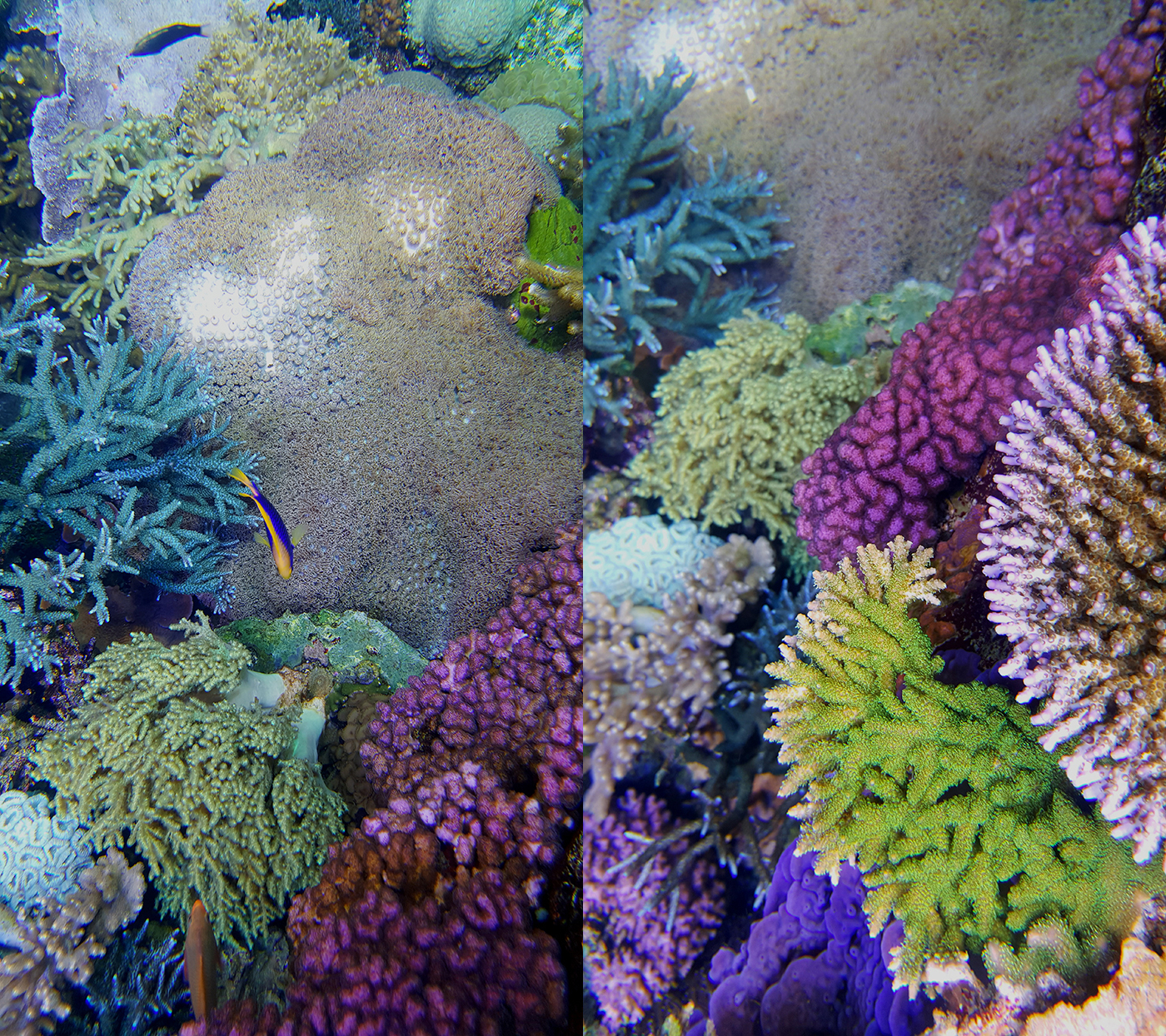
(Left) Chrysiptera starcki, over a huge Turbinaria peltata. (Right) Acropora efflorescens and Acropora sp. Green Table with a variety of corals in the background. Photos by Tim Morrissey.
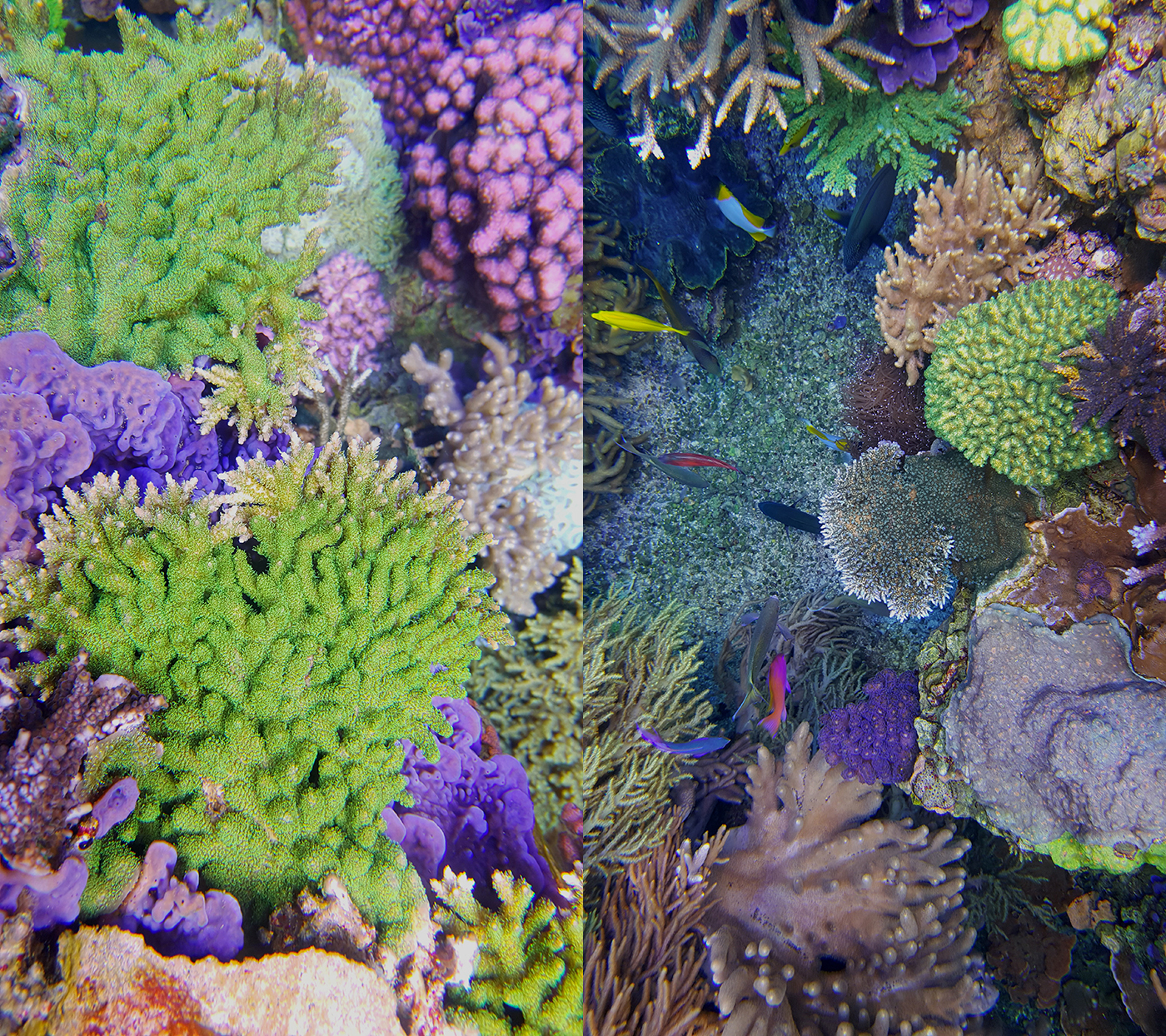
(Left) Acropora sp. Green Table intermixed with Collospongia auris. (Right) A deeper colony of Acropora efflorescens, bordered by green Pocillopora sp., purple Stylophora pistillata, “Miami Hurricane” chalice, and Tridacna squamosa clams on the sandbed. Photos by Tim Morrissey.
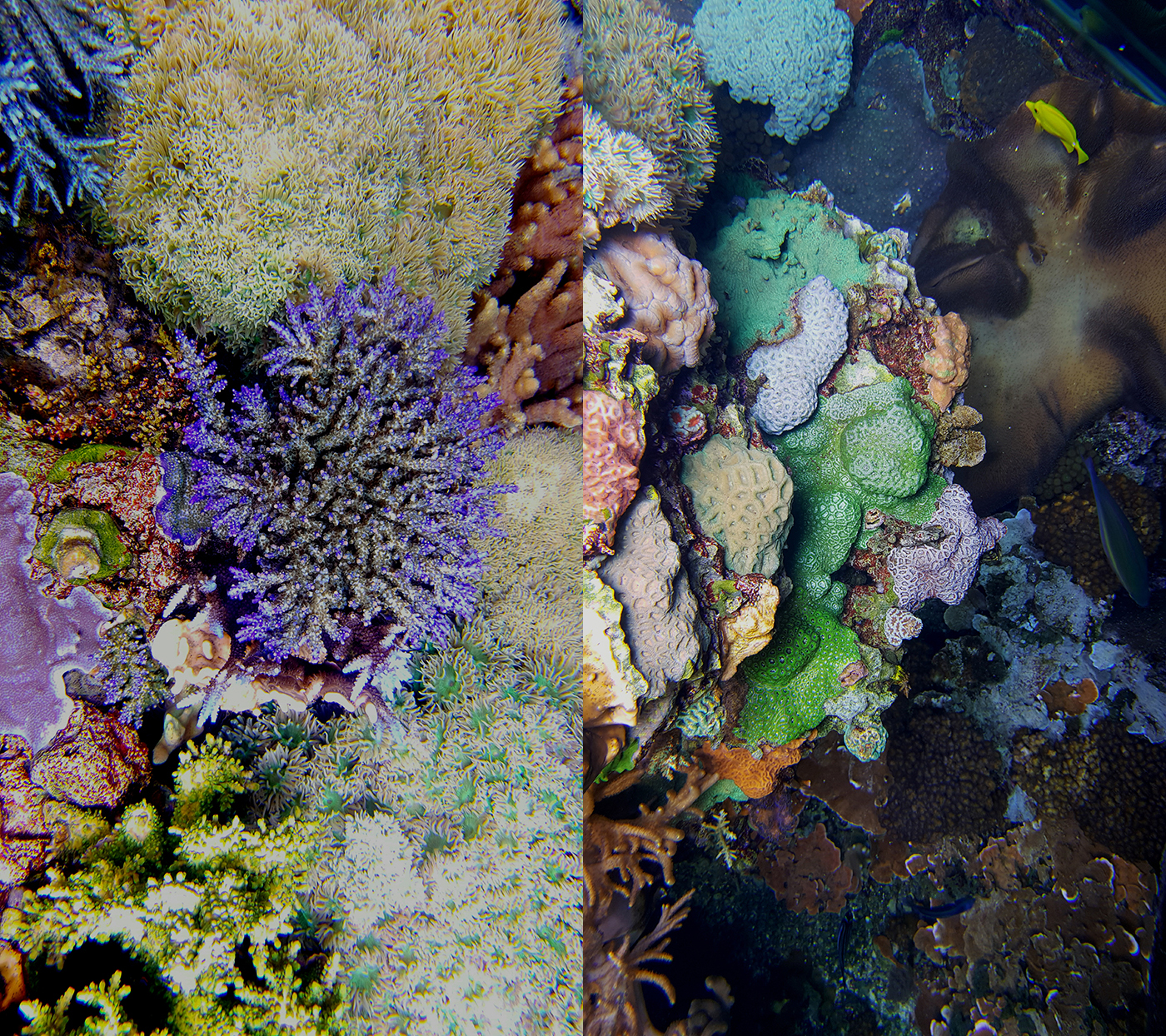
(Left) Acropora valida, Duncanopsammia axifuga, and “Sand dollar” Montipora sp. (Right) LPS alley showing various Micromussa sp. Pavona sp., Caulastrea sp., Leptoseris sp. among others. Photos by Tim Morrissey.
There are many more corals in the tank, but admittedly, I don’t know every single species. I could tell you where they came from if we were looking at the tank in person. Also, as coral taxonomy is rapidly changing, it’s hard to keep up with all of the revised genus and species names. Some people might be surprised by the short coral list, which is smaller than some hobbyist’s collections, but many of the corals in this tank are quite large, with some eclipsing 24 inches in diameter. In my opinion having large corals makes the tank seem much more natural. To achieve this takes patience, when placing corals you have to envision their future growth/size.
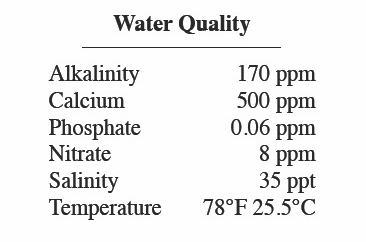 Feeding
Feeding
The tank is fed two to six times a day. Usually, the first feeding is 48-hour live baby brine shrimp. These are hatched at the Scott Aquarium every day and fed out to a variety of our exhibits, mainly the jellyfish, but also coral tanks and aquacultured fish. The next feeding is usually a large feeding consisting of 7-8 sheets of nori, rubber banded to PVC pipes that are hung in three spots as feeding stations for the large herbivores. Initially, the nori was dropped in, but this caused some aggression between the tangs. Some smaller species had cookie-cutter bites out of their fins. Since adding multiple stations and increasing the amount of nori they have all healed nicely. The nori is fed along with PE mysis, Hikari mysis, PE Calanus, and live adult brine. This feeding makes up the bulk of their diet. There are two smaller feeds in the afternoon. One is more 48-hour baby brine and the second is another round of adult live brine. These extra feedings of live food really help the difficult anthias and wrasses put on weight.
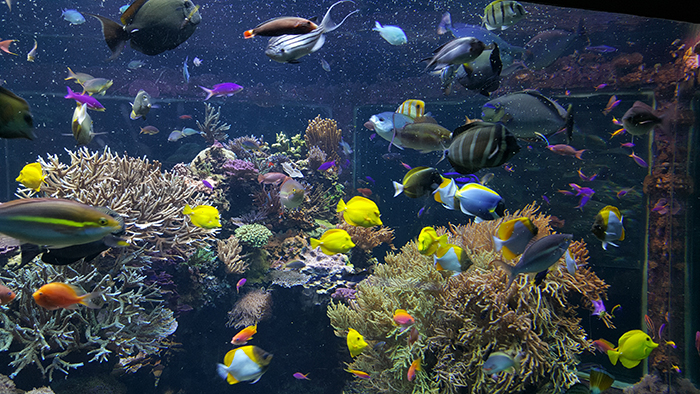
Various fish feeding on mysis shrimp. Photo by Tim Morrissey.
Changes
If I were to redo the tank, I would put the most thought into simplifying the plumbing. There is some unconventional plumbing that can allow for bubbles to reach the large 15-horsepower pump, which can cause gas supersaturation issues. If that could be simplified that would be a huge improvement, but would require completely redoing the tank.

Adding new corals to the tank. Photo by Tim Morrissey.
Things I would like to see in the future would include greater coverage of Acropora sp. corals. It takes time to get big corals, but hopefully the arch will become more of a thicket of Acropora sp. soon. I would also like to decrease the population of mushroom corals. These are the worst pest in my opinion because nothing eats them and they sting many of the nice stony corals. They also seem to come back from nothing. Removing them was and is my number one goal.
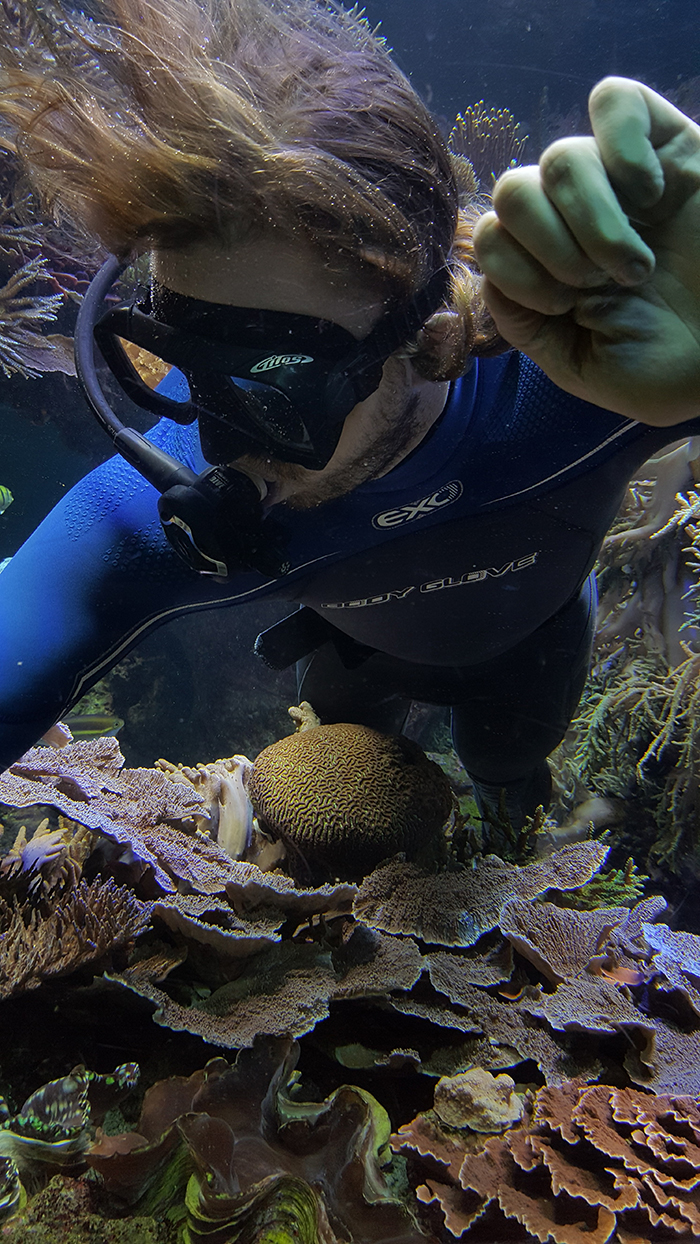
Reaching for something near the window. Photo by Tim Morrissey.
I’m also always looking to add cool animals to the tank. I am reluctant to remove large corals, but over time I would like the coral collection to get more colorful. Being a big fish nerd, obviously, I would like to get more rare and unusual, but also colorful fish. While I do like rare fish, this being a public exhibit, I like them to be colorful. That is why yellow tangs and purple queen anthias are a mainstay. I have also been recently adding some colorful echinoderms to the tank and will probably continue adding more.
As all of you know, a reef tank is always changing, so part of the fun is to enjoy it and appreciate the change as it happens. One of my favorite things to do is to look back at old pictures and pick out certain corals that have grown or been replaced and appreciate the changes that way. In a few months’ time, I’m sure I will look back on this saying. “Wow! Look at the growth on that coral.”
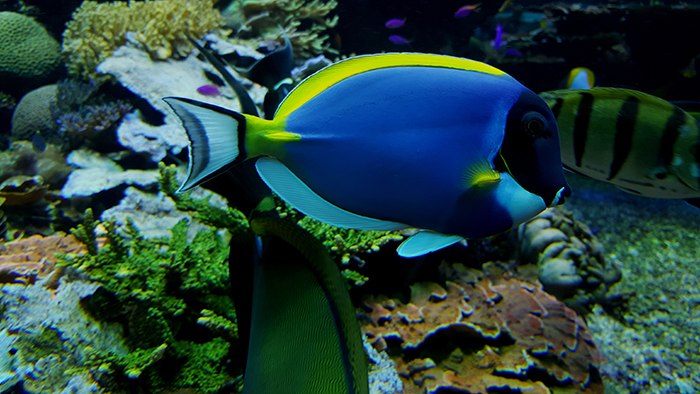
Acanthurus leucosternon, Powder Blue Tang. Photo by Tim Morrissey.
Acknowledgements
I’d like to thank Reefs Magazine for spotlighting my work. Also, none of this would be possible without Omaha’s Henry Doorly Zoo and Aquarium’s, Curator of Aquatics and my boss, Mitch Carl, my teammate, Senior Aquarist, Andrew Hinrichs, along with the rest of the staff at the zoo.



0 Comments